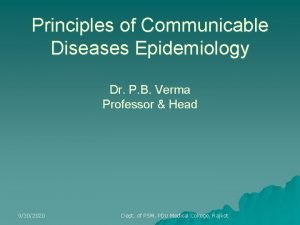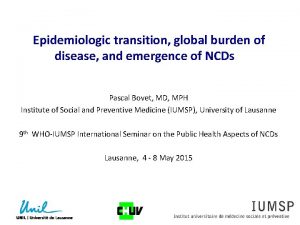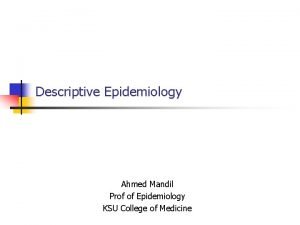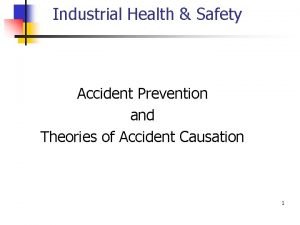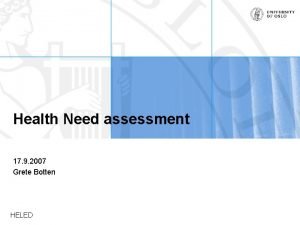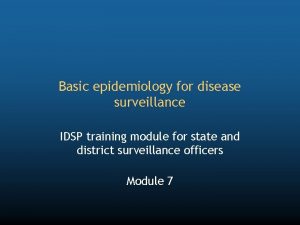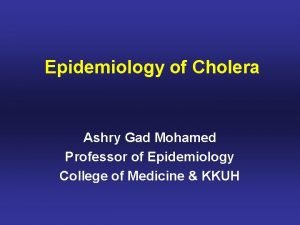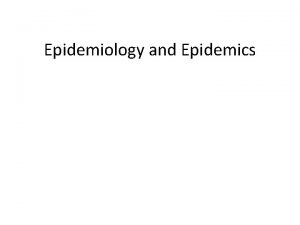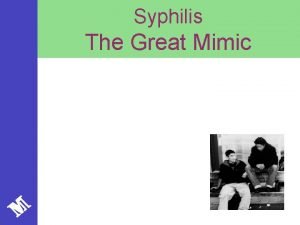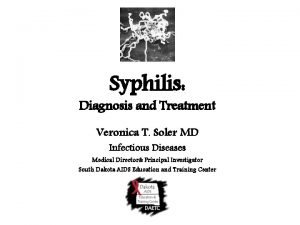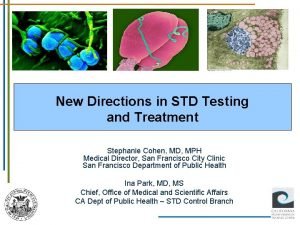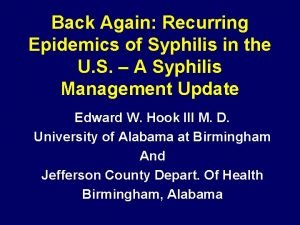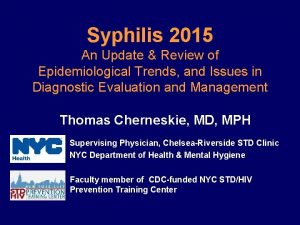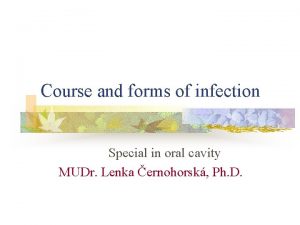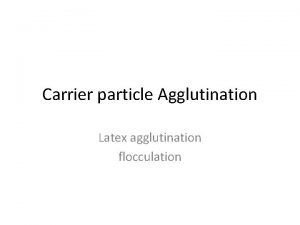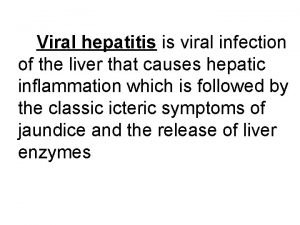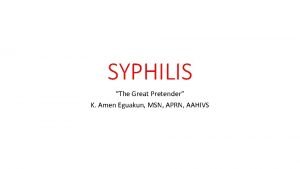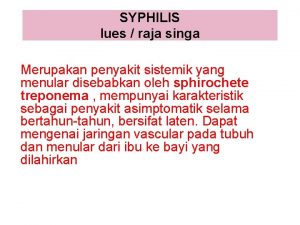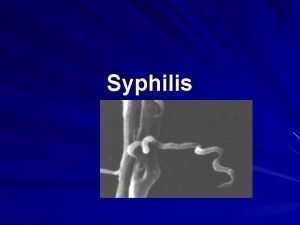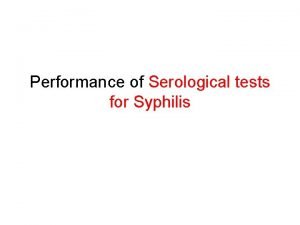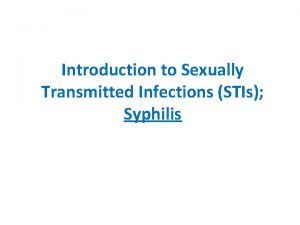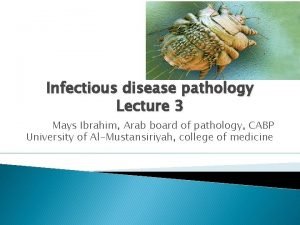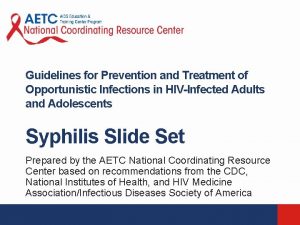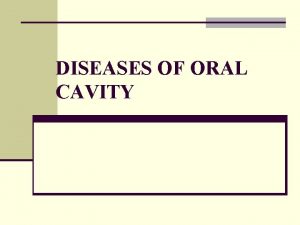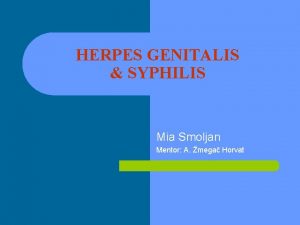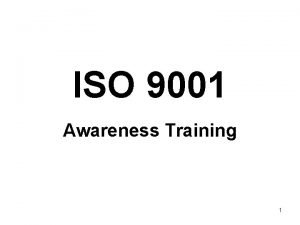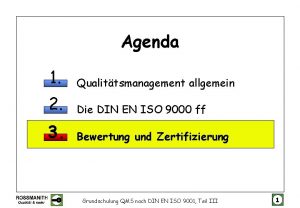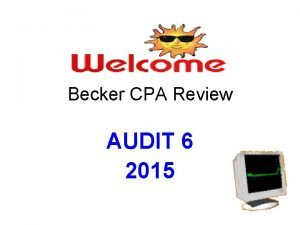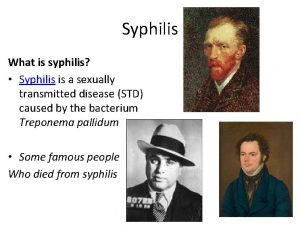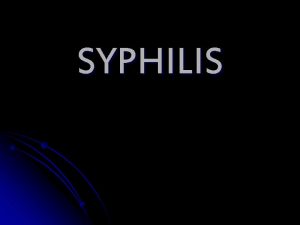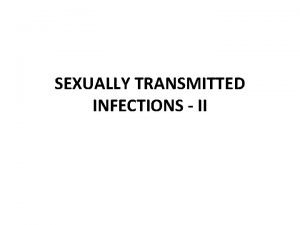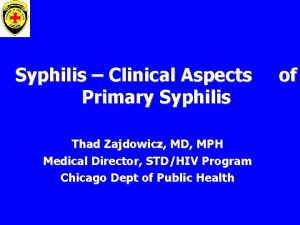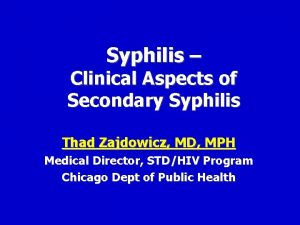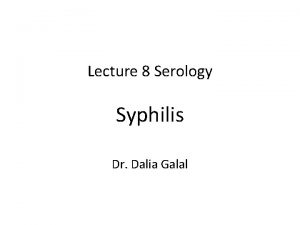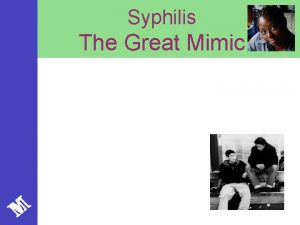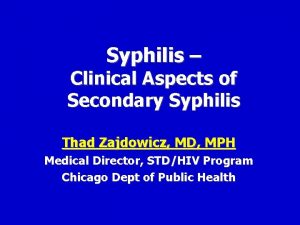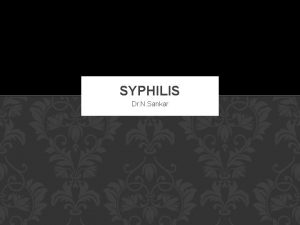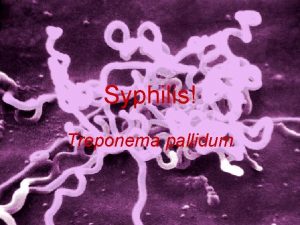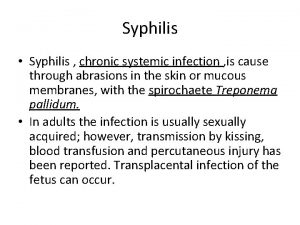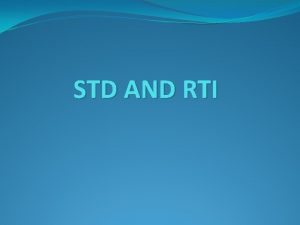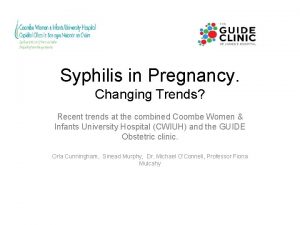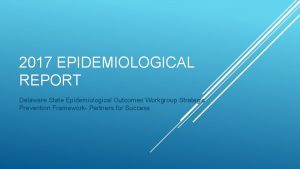Syphilis 2015 An Update Review of Epidemiological Trends


















































- Slides: 50

Syphilis 2015 An Update & Review of Epidemiological Trends, and Issues in Diagnostic Evaluation and Management Thomas Cherneskie, MD, MPH Supervising Physician, Chelsea-Riverside STD Clinic NYC Department of Health & Mental Hygiene Faculty member of CDC-funded NYC STD/HIV Prevention Training Center

Acknowledgements & Disclaimers Disclaimer: ü No personal financial relationship with the manufacturer of any products or services mentioned during todays presentation Thanks to: ü Alison Muse, Director of Bureau of STD Prevention & Epidemiology, NYS DOH ü Preeti Pathela, Bureau of STD Control & Prevention, NYC DOHMH ü Dr. Miguel Sanchez and NYU Department of Dermatology

Syphilis 2015: Session Objectives • Identify the causative organism & clinical course – Incubating infection – Stage “progression” • Explain the current epidemiology of syphilis in NYS – Who is most at risk, in NYS, 2015? • Describe the diagnostic criteria for each stage of syphilis – – Dermatologic exam findings Interpretation of serologic testing results Staging asymptomatic infections Limitations of testing in ruling out suspected infection

Syphilis 2015: Session Objectives (continued) • List the current recommended stage-specific treatments – First-line treatment recommendations – Alternate treatment options – Special patient populations/circumstances • Penicillin allergy • HIV co-infection • Pregnancy – Post-treatment follow-up • Outline approaches to partner management • Access state & local health department resources

Reported Primary and Secondary (P&S) Syphilis New York City, 1940 -2013 Year

18 Case rate (per 100, 000 population) of Reported Primary and Secondary Syphilis New York State and New York City, 1999 -2014 NYC (5527, 2014) 16 Case Rate per 100, 000 population 14 12 10 8 NYS excluding NYC (401, 2014) 6 4 2 0 1999 2001 2003 2005 2007 2009 2011 2013

7 Age Adjusted Rate of Primary and Secondary Syphilis by Gender and Year, NYS excluding NYC, 1999 -2014 8 Males (385 cases, 2014) Case Rate per 100, 000 population 7 6 5 Total (401, 2014) 4 3 2 Females (16 cases, 2014) 1 0 1999 2001 2003 2005 2007 Year of Report 2009 2011 2013

Case rate (per 100, 000 population) of Primary & Secondary Syphilis Diagnoses reported to the NYC DOHMH, 1996 -2014, by sex Males (4816 cases, 2014) 35 25 20 15 10 5 Case Rate per 100, 000 population 30 Total (5527, 2014) Females (656 cases, 2014) 0 1997 1999 2001 2003 2005 2007 2009 2011 2013

9 Rate per 100, 000 men Age-Adjusted Primary and Secondary Syphilis Rates among Males by County, NYS Excluding NYC, 2014

10 Percent Change Increases in Number of Early Syphilis Cases by County, NYS Excluding NYC, 2014

Self-reported HIV status among interviewed MSM primary & secondary syphilis cases, NYC, 2000 -2014 100 % HIV positive 80 60 40 83 55 20 61 47 52 59 60 58 50 58 60 67 63 64 57 20 00 20 01 20 02 20 03 20 04 20 05 20 06 20 07 20 08 20 09 20 10 20 11 20 12 20 13 20 14 0 N=12 65 141 148 208 216 188 350 519 735 539 Year • • • Data based on cases reported to the NYC DOHMH. Interviewed cases only Excludes cases with self-report of unknown HIV status 433 443 607 814

12 Source of Provider Report, Primary and Secondary Syphilis by Race and Year among Males, NYS excl NYC, 2010 -2014 Other Hospital 100% 80% 60% 32% 30% 37% STD Clinic 40% Private MD 20% 0% Overall White Non-Hispanic Black Non-Hispanic Latino


• • Diffuse or Localized Cutaneous Eruption Mucous Patches Condyloma Lata Patchy Alopecia Tertiary- Cardiovascular & Gummatous Neurosyphilis- • Early (CN dysfxn, stroke, ocular) • Late (tabes dorsalis, general paresis) • Asymptomatic Latent- Asymptomatic at time of treatment Early Latent of unknown duration Asymptomatic Primary- Muco-cutaneous ulceration Secondary Symptomatic Stages of Syphilis

Relevance of Accurate Syphilis Staging LATENT PRIMARY SECONDARY EARLY Currently Infectious ? YES Duration of Therapy Bicillin IM x 1 Doxy PO x 2 weeks Management of Sexual Contacts Serologic Response to Treatment Previous 3 months Previous 6 months RPR titer: 2 dilution fall in 6 -12 months UNKNOWN LATE Possibly No Bicillin IM x 3 Doxy PO x 4 weeks Previous 12 months If RPR >/= 1: 32: 2 dilution fall in 12 - 24 months ?

Genital Ulcer Disease The Usual Suspects Genital Herpes- Herpes Simplex Virus types 1 & 2 Primary Syphilis- Treponema pallidum Chancroid - Haemophilus ducreyi Lymphogranuloma Venereum (LGV)- C. trachomatis [Granuloma venereum/Donovanosis- Klebsiella granulomatis] Candidiasis/Balanitis Aphthosis major Behcet’s disease Fixed Drug Eruption Stevens-Johnson Syndrome Lichen Planus (Erosive) Erythema Multiforme Reiter’s Syndrome Trauma Cancer- Squamous Cell

Diagnostic & Screening Tests for Syphilis Sensitivity • Non-Treponemal – RPR – VDRL Specificity Primary 86% Secondary 100% Latent 73% 98% Primary 86% Secondary 100% Latent 96% 97% • Treponeme-specific – FTA-ABS – TPPA – Ig. G EIA • Lesion-based Testing – Darkfield – PCR: Not FDA approved though may be available through individually-validated local labs

Stages of Syphilis Primary • Muco-cutaneous ulceration Secondary • Diffuse or Localized Cutaneous Eruption • Mucous Patches • Condyloma Lata • Patchy Alopecia Latent- Asymptomatic at time of treatment Early Latent of unknown duration Neurosyphilis Tertiary- Cardiovascular & Gummatous

Differential Diagnosis of Secondary Syphilis • • • Pityriasis Rosea Drug eruption Viral exanthem Acute HIV Sarcoidosis (annular lesions)

Latent (Asymptomatic) Syphilis • Interpretation of syphilis serology results • Differentiation of 3 latent syphilis stages – Early Latent (acquired < 12 mo ago) – Latent (acquired > 12 mo ago) – Latent of unknown duration (acquired ? ) • Detection of asymptomatic infections through appropriate screening

NON-TREPONEMAL TREPONEME-SPECIFIC (e. g. RPR, VDRL) (e. g. FTA-ABS, TPPA, EIA) 1. Serum Ab Detected Antibody to cardiolipincholesterol-lecithin antigen Antibody to recombinant treponemal antigen 2. Type of result Provides both qualitative (reactive vs. non-reactive) Qualitative result only and qualitative (titer) results 3. Test difficulty & cost Performed manually with visual interpretation; more labor/time intensive Can be automated; cost saving for large volume laboratories Imperfect specificity 4. Specificity • • Biologic False Positive Lower specificity, therefore must be confirmed by a treponeme-specific test • • Cross-reacting serum antibodies Greater specificity therefore traditionally used to confirm a pos. non-treponemal result

NON-TREPONEMAL TREPONEME-SPECIFIC YES NO • Titers decline following • Can't distinguish current Rx and rises with active (un. Rxed) from past reinfection inactive (previously Rx'ed/cured) infection • Often reverts to non 5. Association reactive after successful • Generally long-lasting with disease Rx reactivity despite curative activity Rx • May revert back to nonreactive even without • May be able to detect old treatment after untreated infection (where prolonged latency RPR lost its reactivity due to low disease activity) Screening patient with no past history of syphilis 6. Clinical uses • Measure post-Rx response • • Detect ASx re-infection in pts w/ past Hx of Rx • Confirm a pos. nontreponemal result May be able to detect old untreated infection

Serologic Interpretation RPR Non-Reactive / FTA-ABS Non-Reactive RPR Non-Reactive/ FTA-ABS Reactive No Syphilis Diagnosis Very Early Primary Syphilis Incubating syphilis infection Secondary Syphilis w/ Prozone (1 -2%) Very Early Primary Syphilis Late untreated syphilis w/ sero-reversal of RPR History of Treated Syphilis Rxed inadvertently in past False-negative Non-Treponemal test False-positive Treponemal Test (rare) RPR Reactive / FTA-ABS Non-Reactive Biologic False Positive False-negative Treponemal Test (rare) RPR Reactive / FTA-ABS Reactive Positive Syphilis Diagnosis Lyme disease Endemic (non-sexual) treponemal ds

BIOLOGIC FALSE POSITIVE REACTION ACUTE (< 6 months) Physiologic Pregnancy Vaccinations Smallpox Typhoid Yellow fever Acute Infections Herpes varicella-zoster Herpes simplex Infectious mononucleosis Measles Mumps Viral hepatitis HIV sero-conversion illness Pneumonia (incl. Mycoplasma) Lyme disease CHRONIC > 6 months Physiologic Older age Chronic Infection Tuberculosis Malaria HIV/AIDS Autoimmune Disorders Lupus Rheumatoid arthritis Autoimmune thyroiditis Other Conditions Malnutrition Malignancy Hepatic cirrhosis Intravenous drug use

Serologic Interpretation RPR Non-Reactive / FTA-ABS Non-Reactive RPR Non-Reactive/ Screening Ig. G Reactive With RPR Non. Reactive FTA-ABS Reactive No Syphilis Diagnosis Very Early Primary Syphilis Incubating syphilis infection Secondary Syphilis w/ Prozone (1 -2%) Very Early Primary Syphilis Late untreated syphilis w/ sero-reversal of RPR History of Treated Syphilis Rxed inadvertently in past False-negative Non-Treponemal test False-positive Treponemal Test (rare) RPR Reactive / FTA-ABS Non-Reactive Biologic False Positive False-negative Treponemal Test (rare) RPR Reactive / FTA-ABS Reactive Positive Syphilis Diagnosis Lyme disease Endemic (non-sexual) treponemal ds

Reverse Sequence Serologic Screening for Syphilis Screening EIA or other Treponeme-Specific Test * NONREACTIV E REACTIVE RPR No Syphilis Infect. Rule Out: • Early primary • Incubating Infect. REACTIVE EIA (+); RPR Reactive Confirmed Syphilis Infection • Current, active, untreated Infection • Old treated (r/o re-infection: ? titer rise) NON-REACTIVE Second Treponeme-specific Test (FTA-ABS, TP-PA, TP Ab) NON-REACTIVE Syphilis Unlikely i. e. False (+) EIA/CIA Rule Out: • Early primary • Incubating Infection • Ulcer on exam - presumptive Rx - lesion-based test - repeat serology 2 wks • Recent expos. to case - presumptive Rx REACTIVE EIA (+); RPR Reactive; TP-PA Reactive Confirmed Syphilis Infection • Very Early Primary (i. e. sero-conversion) • Untreated/ Inadequately Treated −Latent w/ RPR sero-reversal −Partial Rx (after Rx for non-syphilic infection) * EIA: Enzyme immunoassay CIA: Chemiluminescence immunoassay MFI: Multiplex flow immunoassay FTA-ABS: Fluorescent Treponemal Ab, absorption TP-PA: Treponema pallidum particle agglutination

REACTIVE Non-Treponemal (RPR/VDRL) NO YES Reliable/documented treatment Trep-specific (FTA-ABS, TPPA) NONREACTIV E Past history of SYPHILIS INFECTION: syphilis treatment ? PAST or PRESENT ? NO YES REACTIVE Treatment adequate for syphilis stage NO YES Biologic False Positive NO Stage & Treat Adequate post-treatment serologic response YES Evaluation of inadequate response to Rx Re-infection unlikely; Screen PRN NO RPR 2 -Titer Rise from Post-Rx “Baseline” YE S NO Recent known syphilis exposure; or Exam findings suspicious for P/S YES • ? Presumptive Rx • Lesion-based Test • Repeat Titer

Rapid Point-of-Care Syphilis Testing • Immuno-chromatographic treponeme-specific tests • Whole blood or finger stick specimen; results ~10 minutes • Cannot provide quantitative result (i. e. titer) or distinguish past treated vs. active untreated infections • Combination/Dual tests on the horizon – 2 different Abs to same infection (eg. NT Ab + TS Ab) – Abs to 2 different infections (e. g. Syphilis + HIV) • Syphilis Health Check. TM » 2011: FDA approval for use in U. S » Dec. 2014: FDA grants CLIA waiver; dropped from moderate/high complexity classification

Syphilis Staging Reactive Syphilis Serology Primary (ulceration) Clinical exam findings YES consistent w/ syphilis NO Past history of syphilis treatment Within past 12 months NO YES Dermatologic signs of Secondary Exam evidence of Tertiary or Neuro Syphilis 2 dilution RPR titer rise • Confirm with DF or PCR if in doubt • Stage-specific Rx • CSF Exam • Rx based on further evaluation YES within past 12 months NO Non-Reactive RPR (Sero-conversion) Unequivocal Sx of primary/ secondary Exposure to confirmed infectious case 1 st started having sex YES Treat for Early Latent Syphilis YES YES NO Treat for Latent Syphilis * * or Latent Syphilis of Unknown Duration

Increasing Diagnosis & Case Detection • Maintain high index of suspicion in patients presenting with ano-genital ulcers or other dermatologic findings, esp. if increased risk • Be cognizant of limitations in test sensitivity and possibility of false negative results • Identify asymptomatic infections via appropriate levels of screening – Utilize brief sexual history to identify pts at risk – Perform serologic screening when indicated

Syphilis Cases, by Stage and Gender, NYC, 2014 Cases Among Men Cases Among Women 100% 120% 90% 80% 100% N=1905 70% 80% 60% 50% 40% 74% ASx N=1822 60% 94% ASx 40% 30% 20% 10% N=516 20% N=1272 0% Primary & Secondary 0% Early Latent N=126 N=32 Latent/ Latent Unk. Duration

Syphilis Screening: USPSTF • Persons at increased risk for syphilis infection – MSM with high-risk sexual behavior – Commercial sex workers & persons who exchange sex for drugs – Adults in correctional facilities – ? Persons diagnosed with another STI • All pregnant women

CDC Screening Recommendations: http: //www. cdc. gov/std/tg 2015/screening-recommendations • Sexually active MSM – At least annually – Every 3 -6 mo. if increased risk - Multiple partners - Anonymous partners - Illicit drug use (esp. crystal meth) NYC DOHMH, 2014 • Sexually active persons with HIV – At initial HIV evaluation – At least annually – More frequently depending on individual risk behaviors (e. g. q 4 months per AIDS Institute, 2014) • Pregnant women – At 1 st prenatal visit – Early in 3 rd trimester & at delivery if at high risk

Syphilis– Treatment Issues STAGE First Line Drug of Choice Alternative • Primary • Secondary • Early Latent Benzathine PCN 2. 4 m. U IM x 1 Doxycyline 100 mg BID x 14 days • Latent of Unknown Duration Benzathine PCN 2. 4 m. U IM weekly x 3 weeks Doxycyline 100 mg BID x 28 days • • Must ensure use of Bicillin LA (not C-R) Azithromycin (2 g oral) not recommended Caution- Any non-PCN regimen in HIV+ Pregnancy: PCN is the only acceptable regimen Based on 2015 CDC Treatment Guidelines

2004 Packaging Current Packaging

Syphilis Treatment Options- Effectiveness Benzathine Doxycycline PCN EARLY SYPHILIS PRIMARY SECONDARY ✔ EARLY LATENT ✔ PREGNANT WOMAN ✔ HIV-INFECTED ✔ Limited studies Contraindicated Ceftriaxone Azithromycin 2 g Comparable to Bicillin Effective but not in several small studies, 1 st Line due to but daily IM/IV dosing x emergence of 10 -14 days resistance Not well studied Not recommended ? Not well studied; need close follow-up; desensitize if risk of non-compliance Not recommended ✔ Strong clinical trials, observational studies, and decades of clinical experience

CDC Guidance re: Delayed Bicillin Doses Clinical experience suggests that an interval of 10 – 14 days between doses…might be acceptable before restarting Pharmacologic considerations suggest that an interval of 7 to 9 days between doses, if feasible, may be more optimal Missed doses are not acceptable for pregnant patients being treated for latent syphilis 2015 CDC STD Treatment Guidelines

Jarisch-Herxheimer Reaction • Immune-mediated reaction; treponemal endotoxins • 2 -24 hours following initiation of treatment • Fever, headache, myalgias • 50 -75% primary/secondary cases – ↑ with higher titers – ↓ with history of previous treatment • Management: antipyretics, NSAIDs • Pregancy – Preterm labor, uterine contrations, fetal distress – Need for close monitoring but not delay in Rx

2 yrs 9 mo ago Matthew 5 mo ago Jason 3 mo ago thru present Brian Maximum Range for Infectious Period Rash Patient Treated 6 months Symptom Onset Management of Sexual Contacts/Partners Which option is most appropriate for each partner noted above? a. No significant risk of exposure- Forgo any testing/Rx b. Perform screening (by exam and serology) If Positive, provide treatment c. Presumptive treatment, even in face of negative testing

Syphilis: Defining the Communicable Period ? ? LATENT EARLY LATENT SECONDARY PRIMARY 12 6 3 0 Months prior to symptom onset (or diagnosis date if asympt. )

www. inspot. org

Response to Therapy by Syphilis Stage Repeat RPR Titers Stage HIV-negative Primary, Secondary 6 months 12 months Every 3 months x 1 year Recheck at 24 months Early Latent, Latent 6 months 12 months 24 months Every 6 months x 2 years • HIV-positive Primary, Secondary Syphilis - Resolution of symptoms - By 6 -12 months: Fall in RPR by 2 titers • Early Latent, Latent Syphilis - If RPR titer >/= 1: 32 Fall in RPR by 2 titers within 12 -24 months Pts w/ HIV: Rare occurrences of unusual post-treatment serologic responses (e. g. fluctuating or high serofast serologic titers)

Approach to Inadequate Serologic Response to Treatment • Evaluate for possible re-infection • Re-screen for HIV • Consider suboptimal treatment – Inaccurate staging of infection – Non-compliance with oral therapy • Rule out Neurosyphilis (CSF exam) • Re-treat with Bicillin 2. 4 m. U IM x 3

Indications for CSF Exam • Neurologic or Ophthalmic Signs/Symptoms • Evidence of Active Tertiary (aortitis, gumma) • Inadequate Serologic Response to Treatment • HIV+ with Latent or Latent Unknown Dur. HIV+ patients • RPR >/= 1: 32 • CD 4 </= 350 ? ? CSF Exam Although associated with clinical and CSF abnormalities consistent with neurosyphilis- if asymptomatic, no data that CSF exam in these patients improves clinical outcomes Based on 2015 CDC Treatment Guidelines

Neurologic or Ophthalmic Signs/Symptoms of Syphilis • Headache, vertigo, neck stiffness without fever, seizures, focal symptoms • Cognitive dysfunction, mental status or personality changes, dementia, psychosis • Cranial nerve dysfunction (esp. facial/auditory) • Ophtho (optic neuritis, iritis, pupillary dysfxn) • Peripheral neuropathies (lightning pain, sensory/motor or reflex deficiencies, gait disturbance)

CDC Advisory: Identification & Management of Ocular Syphilis • All syphilis cases: 1. Screen for visual/ocular symptoms 2. Perform neuro exam including cranial nerves • Syphilis cases with ocular symptoms: 1. Ophthalmologic eval ASAP 2. CSF Examination • Treatment for 10 -14 days – Aqueous crystalline penicillin G IV or – Procaine penicillin IM with Probenecid • Report case to local/State DOH within 24 hrs

Ocular Syphilis: Common Symptoms • • • Blurred/ decreased vision New onset floaters Redness of the eye Eye pain Photophobia • • • Altered color perception (washed out colors) Scotomas Tearing Blepharospasm (twitching of lid) Pain with eye movement Posterior Uveitis & Panuveitis

CDC Advisory: Identification & Management of Ocular Syphilis • All syphilis cases: 1. Screen for visual/ocular symptoms 2. Perform neuro exam including cranial nerves • Syphilis cases with ocular symptoms: 1. Ophthalmologic eval ASAP 2. CSF Examination • Treatment for 10 -14 days – Aqueous crystalline penicillin G IV or – Procaine penicillin IM with Probenecid • Report case to local/State DOH within 24 hrs

www. cdc. gov/std/tg 2015 or search “CDC STD Treatment”

STD Clinical Resources in New York State NEW YORK STATE Clinical Consultation CEI STD Center for Excellence 1 -866 -637 -2342 Guidance on STD case Reporting http: //www. health. ny. gov/professionals /diseases/reporting/communicable/ NEW YORK CITY Clinical consultations or referrals for Dark Field testing 347 -396 -7274 Syphilis Treatment & Serologic Titer Registry 347 -396 -7201 Alternate contact numbers 347 -396 -7200 1 -866 -NYC-DOH-1 Case Reporting- Directions for http: //www. nyc. gov/html/doh/html/hcp/ Provider Reporting hcp-reporting. shtml
 Backup and recovery techniques
Backup and recovery techniques Epidemiological triad
Epidemiological triad Wheel model of causation
Wheel model of causation Stages of epidemiological transition
Stages of epidemiological transition Abdel omran epidemiological transition
Abdel omran epidemiological transition Obesity and bone health
Obesity and bone health Epidemiological triad
Epidemiological triad Human factors theory
Human factors theory What is epidemiological approach
What is epidemiological approach Emerging infectious diseases
Emerging infectious diseases What is epidemiological approach
What is epidemiological approach Diagnosis epidemiologi adalah
Diagnosis epidemiologi adalah Epidemiological transition model
Epidemiological transition model Dtm model
Dtm model Weil felix reaction
Weil felix reaction Epidemiologic transition
Epidemiologic transition Epidemiological triad of typhoid fever
Epidemiological triad of typhoid fever Epidemiological triad
Epidemiological triad Descriptive vs analytic epidemiology examples
Descriptive vs analytic epidemiology examples Epidemiological transition
Epidemiological transition Early vs late syphilis
Early vs late syphilis Syphilis titer chart
Syphilis titer chart Tabes dorsalis
Tabes dorsalis Chlamydia treatment
Chlamydia treatment Syphilis titer chart
Syphilis titer chart Spirochetales
Spirochetales Syphilis morphology
Syphilis morphology Syphilis
Syphilis Bacteria causing syphilis
Bacteria causing syphilis Oportunne
Oportunne Flocculation
Flocculation Hepatitis b markers interpretation
Hepatitis b markers interpretation K
K Klasifikasi late syphilis
Klasifikasi late syphilis Congenital syphilis triad
Congenital syphilis triad Rpr test result
Rpr test result Syphilis diagnostic test
Syphilis diagnostic test Lymphocytosis
Lymphocytosis Bilhariziasis
Bilhariziasis Herxheimer reaction
Herxheimer reaction Dory flop sign
Dory flop sign Erythematous oropharynx
Erythematous oropharynx What stds are cureable
What stds are cureable Syphilis genitalis
Syphilis genitalis Chapter 9 section 1 labor market trends
Chapter 9 section 1 labor market trends Iso 9001:2015 awareness training
Iso 9001:2015 awareness training Management review iso 9001 version 2015 muster
Management review iso 9001 version 2015 muster Becker and smith cpas performs a financial statement
Becker and smith cpas performs a financial statement Chapter review motion part a vocabulary review answer key
Chapter review motion part a vocabulary review answer key Ap gov review final exam review
Ap gov review final exam review Nader amin-salehi
Nader amin-salehi

